Nikon D700: son of D3 or smarter brother of D300?
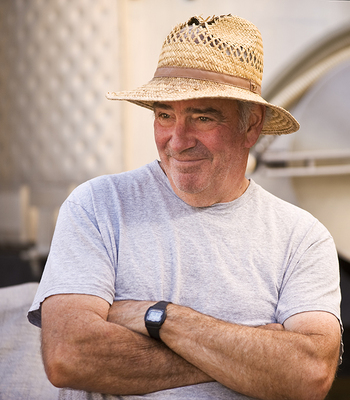
© Chick Harrity
Glenn Cook, owner of Glenn Cook Family Winery where Amnesia and MX Cab are made. – ISO 200, 1/200th at F3.5.
The good news is that YOU get to make the choice of how to use Nikon's smaller, lighter entry into the digital full-frame game!
If you are already an owner of a D3, the D700 is an easy choice as a second camera since it only loses a few features and gains a significant size, weight and price reduction.
If you are a D300 or D2x user and have a collection of DX lenses it is a more affordable first step into full-frame quality and real wide-angle capability since a combo of the D700 body and the excellent FX 24–70mm F2.8 lens is a couple of hundred bucks less that a D3 body alone. So using your smaller chip camera on the telephoto end gives you extra millimeters due to the 1.5 magnification and using the full framer on wide angle gives you the best of both worlds.
Let's see exactly what we lose and/or gain in the D3 to D700 comparison. The D700 uses the same 12.1 MP full-frame (FX) sensor, EXPEED image processor, Multi-CAM 3500FX auto-focus sensor module featuring 51 AF points, and the high-resolution 3-inch LCD monitor with tempered glass providing a 170-degree viewing angle. Its high ISO abilities are also the same and that means quite awesome ISO 3200 and 6400 performances and the ability to go to a noisy but sometimes game-saving 25600! With both of these cameras ISO 1600 and 800 look as good or better than the best ISO 400 the cameras of a year or so ago could produce.

Support our sponsors
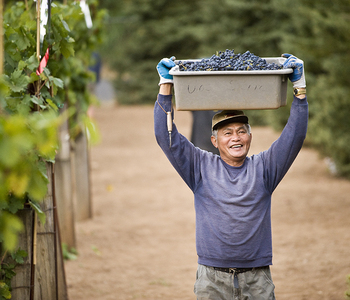
© Chick Harrity
Grapes for Amnesia Zinfandel being picked at H&L Vineyard in St. Helena, Calif. – ISO 3200, 1/200 at F3.5.
On the plus side the D700 adds a self-cleaning sensor, the ability to overlay the Virtual Horizon feature on the Live View Preview image and a built-in pop-up flash. Wait; don't dismiss the pop-up as an amateur feature because it can be set to Commander Mode and trigger external flashes in multiple light setups. Speaking of multiple lights, this might be a good time to recommend Joe McNally's latest book, "The Moment It Clicks." It contains some great tips about using multiple lights creatively.
Now back to what the D700 lost as it slimmed down. A motor that shoots 9 frames a second and has a vertical release coupled with a shutter rated at 300,000 cycles, a viewfinder with 100% coverage and two slots for compact flash cards. Due to the shrinkage in body size the rear info panel is gone and it has other minor menu control differences; in fact the control layout is very much like the D300.
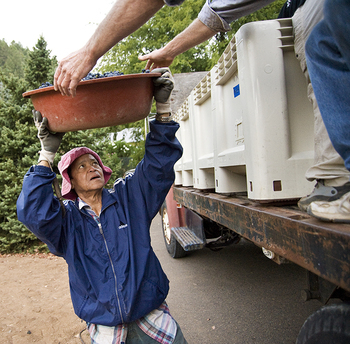
© Chick Harrity
Grapes for Amnesia Zinfandel being picked at H&L Vineyard in St. Helena, Calif. – ISO 3200, 1/320 at F4.5.
The D3 also has a much larger battery that brings to mind two things. When you compare the weight of the two cameras without battery (why the camera companies give you that weight rather than the way you use the camera is still a mystery to me) the D700 is only a little more than a half-pound lighter but when you put the batteries in, the difference jumps to almost a full pound. But the smaller EN-EL3e, same as the D300, battery is pretty amazing. A few days ago I shot a Napa Valley grape harvest from 6 in the morning until 5 p.m., making a total of 1,128 RAW frames and I still had 17% battery life left when I got home. Speaking of similarities with the D300, the D700 uses the same optional battery grip (MB-D10) as the D300 which not only bumps your FPS second rate from 5 to 8 but if you are using both cameras you can switch the grip from camera to camera, saving both money and weight.
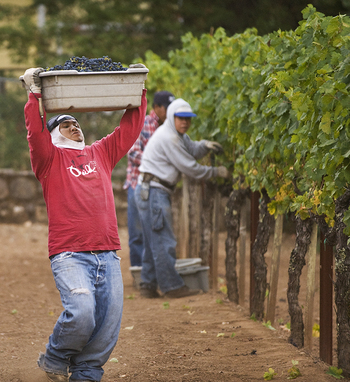
© Chick Harrity
Grapes for Amnesia Zinfandel being picked at H&L Vineyard in St. Helena, Calif. – ISO 3200, 1/200 at F4.5.
So the camera is smaller and lighter than the D3 but not to worry, it is solidly built, well insulated from moisture and dust and feels very good in the hands. Everything seems to fall into place and I found it very comfortable to use for extended periods.
One thing to remember: while the D700 will accept DX lenses, they do not cover the full frame. The focus screen in DX mode now is indicated with a rectangle rather than the shaded area of the D3 and you wind up with only a 5.1 Meg file, not optimal in this day and age. So the move to full frame will mean new lenses unless you have a bag full of them from back in your film days. Fortunately you can still use most of your old Nikon lenses, only losing metering and auto focus features relative to the age of the lens.
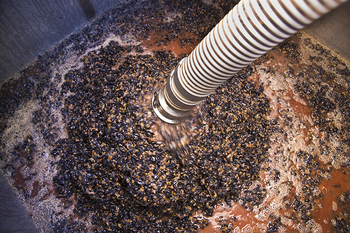
© Chick Harrity
Grapes for Amnesia Zinfandel are pumped into storage tank for fermentation after going through a destemmer. – ISO 400, 1/10th at F6.3.
Summing up, the D700 reminds me a lot of when Nikon introduced the F100 way back in 1999 when most of us were still using film. It was the first time Nikon thought enough of a camera to give the F designation to anything but its flagship model. I grew to love the F100 because it was smaller and lighter than the F5 and did almost everything that its big brother could do. I found that I didn't need the high-speed motor on all three of the cameras that I was lugging around so I tried two F5s and one F100. It didn't take long before I was carrying three F100s except for sports assignments. My back and shoulders thanked me at the end of the day and most importantly, I didn't miss any more pictures than usual.
That seems to be the case with the D700 and I really enjoyed using it for this year's Harvest. I just might have to get myself at least one.
Chick Harrity has been playing in photojournalism for 51 years, 34 of them in Washington, D.C. His first staff job was in 1956 with his hometown newspaper, the Reading (Pa.) Times. He moved to New York City with The Associated Press in 1965 and worked in Albany and Chicago for a year each before moving to the AP Washington bureau in 1968. In 1981 he had a chance to try the magazine business at U.S. News and World Report where he stayed for 20 years, being named chief photographer in 1985. On April Fool's Day of 2001 he left U.S. News to move to Northern California where he is now the Photo Coach and contributing photographer for the Calistoga Tribune, a new and thriving 1,250-circulation weekly at the top of the Napa Valley. Highlights along the way include receiving the Associated Press Managing Editors' award for Excellence in Photography; being named the White House News Photographers' Association Photographer of the Year, and being awarded the Leica Medal of Excellence for Photojournalism. His first camera was a Kodak Baby Brownie Special. He worked his way up to a 4x5 Speed Graphic and then down again. He was last seen playing with Nikon D200s and D80s.